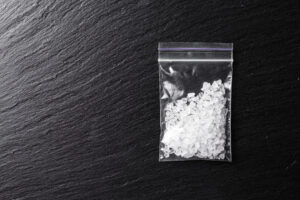MDPV, also known as Methylenedioxypyrovalerone, is a Schedule 1 designer drug ingredient commonly found in “bath salts” that is illegal in the United States. While this chemical produces stimulant effects similar to cocaine or meth, it also causes hallucinogenic effects. When used, MDPV inhibits the reuptake process of dopamine, norepinephrine, and serotonin within the brain, causing a surge in these feel-good neurotransmitters which is what makes it so addictive.
Because this is a relatively new drug that people are using, little research has been done on humans. Most of the information out there is based on rat trials and accounts from people who have used MDPV recreationally. Regardless of this information, MDPV is dangerous and can lead to long-term health complications and death.
Effects of MDPV
Because this drug combines stimulant and hallucinogen effects, the symptoms a person experiences may vary and can cause extreme changes in mood and state of mind. Some of the more common effects include:
- Increased Heart Rate
- Increased Blood Pressure
- Feelings of Euphoria
- Increased Sensations
- Severe Panic Attacks
- Hallucinations
- Aggressive or Violent Behavior
- Seizures
- Death
Though many of these are similar to the effects produced by cocaine, MDPV is at least 10 times more powerful and can continue to cause symptoms even after the drug has moved through the body. Because it is such a powerful drug, many people become addicted very quickly and continue using it to an increased degree to achieve the same effects as their first use.
In general, men and women typically choose to use bath salts, or MDPV, because it is cheaper than cocaine or meth but produces similar effects. It is an easily accessible drug that can cause an increase in euphoric sensations which is what these people crave, but there is a fine line between those positive feelings and the more negative hallucinations or aggression that may also co-occur.
Why Is MDPV So Dangerous?
MDPV inhibits the brain’s ability to recycle excess dopamine, serotonin, and norepinephrine. Because of this, there is an increased amount of these neurotransmitters which causes the individual to experience heightened euphoria. The degree to which the person experiences these feelings causes their brain to crave that “new normal.” More and more of the drug will be needed in order to achieve those same effects. This is why MDPV is so addictive.
Unfortunately, MDPV is not just addictive because it also causes extremely negative psychoactive and physical effects that can be deadly. Many people experience delirium, increased violent behavior, and increased suicidality. MDPV is a designer drug, so there are a number of chemicals that could be mixed into one batch, all of which can contribute to these negative effects.
The most concerning aspect of MDPV is that these side effects and behavioral disturbances can often be felt up to 4 weeks after the bath salts have been used. On top of that, when individuals come down from their MDPV high, withdrawal symptoms include depression, panic attacks, delirium, aggression towards others, and psychotic episodes. In order to diminish these symptoms, users may try to take more of the drug but when it comes to MDPV, delirium and other negative symptoms may worsen.

MDPV Overdoses
MDPV overdoses have been on the rise over the past several years. While overdoses on “bath salts are increasingly common, there is often a mixture of different cathinones in bath salts. That being said, MDPV has been present in more serious overdoses and more fatalities than other cathinones commonly found in bath salts. Some of the more common outward signs of MDOV overdoses include:
- Tachycardia
- Acute Hypertension (sharp increases in blood pressure)
- Hyperthermia (dangerously high body temperature)
- Seizures
- Psychosis
The method of MDPV overdose complications is unclear as of this writing, but one study has found a variety of metabolic and electrolyte imbalances which can lead to serious issues. Some of the more common metabolic disturbances are acidosis, hyponatremia (low sodium in blood), hypernatremia (high sodium in blood), and hypokalemia (low potassium in blood). There was also a range of blood sugar disturbances including both hyperglycemia (high blood sugar) and hypoglycemia (low blood sugar).
Another concerning issue among MDPV overdoses was the prevalence of rhabdomyolysis. This normally occurs due to serious muscle injury, but when it occurs due to MDPV overdose, it is thought to be due to heart failure, liver failure, and/or kidney failure. There have been documented cases of multiple organ failure due to MDPV overdoses as well as several deaths caused by MDPV use.
MDPV Addiction
MDPV, like most other drugs of abuse, has the potential to create both physical and psychological addiction. Specifically, MDPV is a dopamine reuptake inhibitor and a norepinephrine reuptake inhibitor. It works by affecting the same systems as methamphetamine and cocaine. This is also a good reference to its addictive potential. MDPV in particular is the most potent dopamine reuptake inhibitor out of all of the cathinones. Moreso, it is also a more potent dopamine reuptake inhibitor than methamphetamine and MDMA.
Recent research performed by NIDA’s Chemistry and Drug Metabolism Section of the Intramural Research Program in Baltimore found that MDPV is much more addictive than the more common “ring-substituted cathinones” such as mephedrone and methylone. The addictive potential of MDPV is serious, and if someone is struggling with MDPV addiction, then seeking medical help can provide the best possible chances for recovery.
Treating MDPV Addiction
There is little research on MDPV, especially when it comes to the way that the drug affects humans because this is such a new drug. But because this drug has similar effects to cocaine and meth, treatment plans can be determined based on how those drugs affect people. The best method of treatment for MDPV is through an addiction treatment facility that employs medical professionals who have experience helping individuals with an addiction to bath salts.
Clients may need to be monitored during the detoxification phase, but this depends on the individual because of the varying lengths of side effects that can be seen with MDPV use. Treatment programs may also include different behavioral therapies, support groups, psychiatric medications that are not addictive, and any other therapies or interventions that the treatment team determines will be most effective for that individual client.
